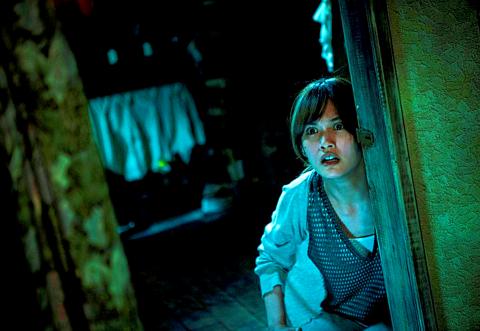The first half of The Tag Along 2 (紅衣小女孩2) has all the elements of an iconic Taiwanese horror movie: spine-tingling scenes of anticipation, jump scares, interpersonal drama and a healthy dose of traditional Taoist elements, including worship of the Tiger Lord (虎爺). Oh, and lots of gore. The entire movie is shot in dark, subdued and cold tones, heightening the feeling of despair.
We’ll get to the second half in a bit.
Like the previous film, the main antagonist here is the “little girl in red,” who became a popular legend in Taiwan when a video of her following a family of hikers was shown during a paranormal television show in 1988. None of the hikers knew who she was, or recalled seeing her that day. The first film builds on the legend while leaving much to the audience’s imagination, but this one completely blows it open by revealing the girl’s backstory and fate.

Photo courtesy of atmovies.com

Those left puzzled after the first film will find many answers in this one — but at the same time, it’s a let down because the answers are pretty standard ghost movie fare. And by revealing everything, the mystery is gone and the producer is stuck with a pretty bland premise to complete the promised trilogy. What would there be left to say?
Despite her eternally youthful appearance, Rainie Yang (楊丞琳) manages to convincingly play a single mother whose pregnant teenage daughter goes missing. Her bid to rescue her daughter from the evil forces featured in the previous film becomes the main plot of the film.
However, Tiffany Ann Hsu’s (許瑋甯) superb performance as a tortured woman who lost her husband and grandmother to the demons in the first film is mostly wasted in the second half as things start to get chaotic (even for a horror film) and the story becomes lost in plot holes the size of the Pacific Ocean — one of them being her character’s purpose in the film. Did the director just write her into the story to appeal to fans of part one? She’s also involved in some of the major plot holes — how does she just waltz into a children’s home and leave with one of the kids without anyone noticing?
Sometimes horror films should stay straightforward and stick to scaring people. Instead, The Tag-Along 2 suffers from a common problem Taiwanese films seem to have: trying to do too much. Most notably, there’s too much sap that continues to build as the touching family drama reaches a boiling point and everybody reaches an overly-emotional grand catharsis, letting go of the past and looking forward.
At several points it even ventures into borderline superhero territory (Taiwanese Tiger-man, anyone?), especially with the sort-of-epic battle scenes that are plagued by cheesy special effects, which is very disappointing given the director’s masterful lighting and mood setting techniques.
And on top of everything, it explores the theme of teen pregnancy and motherhood, which culminates in a bizarre abortion sequence that wouldn’t look out of place in an anti-abortion campaign video.

With so much going on, the viewer ends up overloaded and hoping that the next scene concludes the movie. Sorry, it doesn’t. Ambition is good, but it cannot be said enough that less is more in most cases.
For those who enjoy tearful, feel-good dramas as well as horror, The Tag-Along 2 actually provides a unique cinematic experience, as you will likely end up being immensely moved, grossed out and frightened at the same time. Just ignore the parts that don’t make sense.

In the next few months tough decisions will need to be made by the Taiwan People’s Party (TPP) and their pan-blue allies in the Chinese Nationalist Party (KMT). It will reveal just how real their alliance is with actual power at stake. Party founder Ko Wen-je (柯文哲) faced these tough questions, which we explored in part one of this series, “Ko Wen-je, the KMT’s prickly ally,” (Aug. 16, page 12). Ko was open to cooperation, but on his terms. He openly fretted about being “swallowed up” by the KMT, and was keenly aware of the experience of the People’s First Party

Aug. 25 to Aug. 31 Although Mr. Lin (林) had been married to his Japanese wife for a decade, their union was never legally recognized — and even their daughter was officially deemed illegitimate. During the first half of Japanese rule in Taiwan, only marriages between Japanese men and Taiwanese women were valid, unless the Taiwanese husband formally joined a Japanese household. In 1920, Lin took his frustrations directly to the Ministry of Home Affairs: “Since Japan took possession of Taiwan, we have obeyed the government’s directives and committed ourselves to breaking old Qing-era customs. Yet ... our marriages remain unrecognized,

Not long into Mistress Dispeller, a quietly jaw-dropping new documentary from director Elizabeth Lo, the film’s eponymous character lays out her thesis for ridding marriages of troublesome extra lovers. “When someone becomes a mistress,” she says, “it’s because they feel they don’t deserve complete love. She’s the one who needs our help the most.” Wang Zhenxi, a mistress dispeller based in north-central China’s Henan province, is one of a growing number of self-styled professionals who earn a living by intervening in people’s marriages — to “dispel” them of intruders. “I was looking for a love story set in China,” says Lo,

During the Metal Ages, prior to the arrival of the Dutch and Chinese, a great shift took place in indigenous material culture. Glass and agate beads, introduced after 400BC, completely replaced Taiwanese nephrite (jade) as the ornamental materials of choice, anthropologist Liu Jiun-Yu (劉俊昱) of the University of Washington wrote in a 2023 article. He added of the island’s modern indigenous peoples: “They are the descendants of prehistoric Formosans but have no nephrite-using cultures.” Moderns squint at that dynamic era of trade and cultural change through the mutually supporting lenses of later settler-colonialism and imperial power, which treated the indigenous as